Transcriptomic Analysis Reveals Patterns of Expression of Stage-Specific Genes in Early Apis cerana Embryos
Abstract
1. Introduction
2. Materials and Methods
2.1. Sample Collection
2.2. Total RNA Extraction and PacBio Iso-Seq and Illumina RNA-Seq
2.3. Long-Read RNA Alignment and Isoform Identification
2.4. Mapping and Quality Control of the Illumina RNA-Seq Data
2.5. Gene Ontology and Kyoto Encyclopedia of Genes and Genomes Analysis
2.6. Quantitative Real-Time Polymerase Chain Reaction
3. Results
3.1. Comparative Analysis of Sex-Specific Splicing and Gene Expression
3.2. Analysis of Differentially Expressed Genes
3.3. Analysis of Gene Ontology Functional Enrichment
3.4. Analysis of Sex-Specific Alternative Splicing
4. Discussion
5. Conclusions
Supplementary Materials
Author Contributions
Funding
Institutional Review Board Statement
Informed Consent Statement
Data Availability Statement
Conflicts of Interest
References
- Winston, M. The Biology of the Honey Bee; Harvard University Press: Cambridge, MA, USA, 1991. [Google Scholar]
- Fleig, R.; Sander, K. Embryogenesis of the honeybees Apis mellifera L. (Hymenoptera: Apidae): An SEM study. Int. J. Insect Morphol. Embryol. 1986, 15, 449–462. [Google Scholar] [CrossRef]
- Hu, X.; Ke, L.; Wang, Z.; Zeng, Z. Dynamic transcriptome landscape of Asian domestic honeybees (Apis cerana) embryonic development revealed by high-quality RNA sequencing. BMC Dev. Biol. 2018, 18, 11. [Google Scholar] [CrossRef] [PubMed]
- Wang, M.; Chen, D.; Zheng, H.; Zhao, L.; Xue, X.; Yu, F.; Cheng, C.; Niu, Q.; Wang, S.; Zhang, Y.; et al. Sex-specific development in haplodiploid honeybees is controlled by the female-embryo-specific activation of thousands of intronic lncRNAs. Front. Cell Dev. Biol. 2021, 9, 690167. [Google Scholar] [CrossRef] [PubMed]
- Koetz, A.H. Ecology, behaviour and control of Apis cerana with a focus on relevance to the Australian incursion. Insects 2013, 4, 558–592. [Google Scholar] [CrossRef] [PubMed]
- Bertholf, L.M. The moults of the honeybees. J. Econ. Entomol. 1925, 18, 380–384. [Google Scholar] [CrossRef]
- Hrassnigg, N.; Crailsheim, K. Differences in drone and worker physiology in honeybees (Apis mellifera). Apidologie 2005, 36, 255–277. [Google Scholar] [CrossRef]
- Li, Z.; Huang, Z.Y.; Sharma, D.B.; Xue, Y.; Wang, Z.; Ren, B. Drone and worker brood microclimates are regulated differentially in honey bees, Apis mellifera. PLoS ONE 2016, 11, e0148740. [Google Scholar]
- Osborne, P.W.; Dearden, P.K. Expression of Pax group III genes in the honeybees (Apis mellifera). Dev. Genes Evol. 2005, 215, 499–508. [Google Scholar] [CrossRef] [PubMed]
- Dearden, P.K.; Duncan, E.J.; Wilson, M.J. Immunohistochemistry on Honeybee (Apis mellifera) Embryos. Cold Spring Harb. Protoc. 2009, 2009, pdb.prot5227. [Google Scholar] [CrossRef]
- Eid, J.; Fehr, A.; Gray, J.; Luong, K.; Lyle, J.; Otto, G.; Peluso, P.; Rank, D.; Baybayan, P.; Bettman, B.; et al. Real-Time DNA Sequencing from Single Polymerase Molecules. Science 2009, 323, 133–138. [Google Scholar] [CrossRef]
- Baral, S.; Arumugam, G.; Deshmukh, R.; Kunte, K. Genetic architecture and sex-specific selection govern modular, male-biased evolution of doublesex. Sci. Adv. 2019, 5, eaau3753. [Google Scholar] [CrossRef]
- Khamis, A.M.; Hamilton, A.R.; Medvedeva, Y.A.; Alam, T.; Alam, I.; Essack, M.; Umylny, B.; Jankovic, B.R.; Naeger, N.L.; Suzuki, M.; et al. Insights into the Transcriptional Architecture of Behavioral Plasticity in the Honey Bee Apis mellifera. Sci. Rep. 2015, 5, 11136. [Google Scholar] [CrossRef] [PubMed]
- Zhang, H.; Chen, W.; Zhu, D.; Zhang, B.; Xu, Q.; Shi, C.; He, H.; Dai, X.; Li, Y.; He, W.; et al. Population-level exploration of alternative splicing and its unique role in controlling agronomic traits of rice. Plant Cell 2024, 36, 4372–4387. [Google Scholar] [CrossRef] [PubMed]
- Calixto, C.P.; Guo, W.; James, A.B.; Tzioutziou, N.A.; Entizne, J.C.; Panter, P.E.; Knight, H.; Nimmo, H.G.; Zhang, R.; Brown, J.W. Rapid and Dynamic Alternative Splicing Impacts the Arabidopsis Cold Response Transcriptome. Plant Cell 2018, 30, 1424–1444. [Google Scholar] [CrossRef] [PubMed]
- Burtis, K.C.; Baker, B.S. Drosophila doublesex gene controls somatic sexual differentiation by producing alternatively spliced mRNAs encoding related sex-specific polypeptides. Cell 1989, 56, 997–1010. [Google Scholar] [CrossRef]
- Beye, M.; Hasselmann, M.; Fondrk, M.K.; Page, R.E., Jr.; Omholt, S.W. The Gene csd Is the Primary Signal for Sexual Development in the Honeybee and Encodes an SR-Type Protein. Cell 2003, 114, 419–429. [Google Scholar] [CrossRef]
- Cho, S.; Huang, Z.Y.; Zhang, J. Sex-specific splicing of the honeybees doublesex gene reveals 300 million years of evolution at the bottom of the insect sex-determination pathway. Genetics 2007, 177, 1733–1741. [Google Scholar] [CrossRef] [PubMed]
- Gibilisco, L.; Zhou, Q.; Mahajan, S.; Bachtrog, D. Alternative Splicing within and between Drosophila Species, Sexes, Tissues, and Developmental Stages. PLOS Genet. 2016, 12, e1006464. [Google Scholar] [CrossRef] [PubMed]
- Rogers, T.F.; Palmer, D.H.; E Wright, A. Sex-Specific Selection Drives the Evolution of Alternative Splicing in Birds. Mol. Biol. Evol. 2020, 38, 519–530. [Google Scholar] [CrossRef] [PubMed]
- An, D.; Cao, H.X.; Li, C.; Humbeck, K.; Wang, W. Isoform sequencing and state-of-art applications for unravelling complexity of plant transcriptomes. Genes 2018, 9, 43. [Google Scholar] [CrossRef]
- Wang, J.; Dean, D.C.; Hornicek, F.J.; Shi, H.; Duan, Z. RNA sequencing (RNA-Seq) and its application in ovarian cancer. Gynecol. Oncol. 2019, 152, 194–201. [Google Scholar] [CrossRef] [PubMed]
- Wijeratne, S.; Gonzalez, M.E.H.; Roach, K.; Miller, K.E.; Schieffer, K.M.; Fitch, J.R.; Leonard, J.; White, P.; Kelly, B.J.; Cottrell, C.E.; et al. Full-length isoform concatenation sequencing to resolve cancer transcriptome complexity. BMC Genom. 2024, 25, 122. [Google Scholar] [CrossRef]
- Wang, B.; Kumar, V.; Olson, A.; Ware, D. Reviving the Transcriptome Studies: An Insight Into the Emergence of Single-Molecule Transcriptome Sequencing. Front. Genet. 2019, 10, 384. [Google Scholar] [CrossRef] [PubMed]
- Xia, Y.; Jin, Z.; Zhang, C.; Ouyang, L.; Dong, Y.; Li, J.; Guo, L.; Jing, B.; Shi, Y.; Miao, S.; et al. TAGET: A toolkit for analyzing full-length transcripts from long-read sequencing. Nat. Commun. 2023, 14, 5935. [Google Scholar] [CrossRef]
- Naftaly, A.S.; Pau, S.; White, M.A. Long-read RNA sequencing reveals widespread sex-specific alternative splicing in threespine stickleback fish. Genome Res. 2021, 31, 1486–1497. [Google Scholar] [CrossRef] [PubMed]
- Zhang, H.; Liang, Y.; Chen, S.; Xuan, Z.; Jiang, Y.; Li, R.; Cao, Y. Full-length transcriptome sequencing reveals extreme incomplete annotation of the goat genome. Anim. Genet. 2023, 54, 421–424. [Google Scholar] [CrossRef]
- Zhao, L.; Wang, H.; Li, P.; Sun, K.; Guan, D.-L.; Xu, S.-Q. Genome Size Estimation and Full-Length Transcriptome of Sphingonotus tsinlingensis: Genetic Background of a Drought-Adapted Grasshopper. Front. Genet. 2021, 12, 678625. [Google Scholar] [CrossRef] [PubMed]
- Kuo, R.I.; Cheng, Y.; Zhang, R.; Brown, J.W.S.; Smith, J.; Archibald, A.L.; Burt, D.W. Illuminating the dark side of the human transcriptome with long read transcript sequencing. BMC Genom. 2020, 21, 751. [Google Scholar] [CrossRef]
- Tardaguila, M.; de la Fuente, L.; Marti, C.; Pereira, C.; Pardo-Palacios, F.J.; del Risco, H.; Ferrell, M.; Mellado, M.; Macchietto, M.; Verheggen, K.; et al. SQANTI: Extensive characterization of long-read transcript sequences for quality control in full-length transcriptome identification and quantification. Genome Res. 2018, 28, 396–411. [Google Scholar] [CrossRef] [PubMed]
- Pardo-Palacios, F.J.; Arzalluz-Luque, A.; Kondratova, L.; Salguero, P.; Mestre-Tomás, J.; Amorín, R.; Estevan-Morió, E.; Liu, T.; Nanni, A.; McIntyre, L.; et al. SQANTI3: Curation of long-read transcriptomes for accurate identification of known and novel isoforms. Nat. Methods 2024, 21, 793–797. [Google Scholar] [CrossRef]
- Kim, D.; Langmead, B.; Salzberg, S.L. HISAT: A fast spliced aligner with low memory requirements. Nat. Methods 2015, 12, 357–360. [Google Scholar] [CrossRef] [PubMed]
- Li, H.; Handsaker, B.; Wysoker, A.; Fennell, T.; Ruan, J.; Homer, N. The Sequence Alignment/Map format and SAMtools. Bioinformatics 2009, 25, 2078–2079. [Google Scholar] [CrossRef]
- Liao, Y.; Smyth, G.K.; Shi, W. feature Counts: An efficient general purpose program for assigning sequence reads to genomic features. Bioinformatics 2014, 30, 923–930. [Google Scholar] [CrossRef]
- Grabherr, M.G.; Haas, B.J.; Yassour, M.; Levin, J.Z.; Thompson, D.A.; Amit, I.; Adiconis, X.; Fan, L.; Raychowdhury, R.; Zeng, Q.D.; et al. Full-length transcriptome assembly from RNA-Seq data without a reference genome. Nat. Biotechnol. 2011, 29, 644–652. [Google Scholar] [CrossRef]
- Cantalapiedra, C.P.; Hernández-Plaza, A.; Letunic, I.; Bork, P.; Huerta-Cepas, J. eggNOG-mapper v2: Functional Annotation, Orthology Assignments, and Domain Prediction at the Metagenomic Scale. Mol. Biol. Evol. 2021, 38, 5825–5829. [Google Scholar] [CrossRef] [PubMed]
- Fujinaga, D.; Gu, J.; Kawahara, H.; Ogihara, M.H.; Kojima, I.; Takeshima, M.; Kataoka, H. Twenty-hydroxyecdysone produced by dephosphorylation and ecdysteroidogenesis regulates early embryonic development in the silkmoth, Bombyx mori. Insect Biochem. Mol. Biol. 2020, 127, 103491. [Google Scholar] [CrossRef] [PubMed]
- Yang, Q.; De Schutter, K.; Chen, P.; Van Damme, E.J.M.; Smagghe, G. RNAi of the N-glycosylation-related genes confirms their importance in insect development and α-1,6-fucosyltransferase plays a role in the ecdysis event for the hemimetabolous pest insect Nilaparvata lugens. Insect Sci. 2022, 29, 91–99. [Google Scholar] [CrossRef]
- Karaiskos, N.; Wahle, P.; Alles, J.; Boltengagen, A.; Ayoub, S.; Kipar, C.; Kocks, C.; Rajewsky, N.; Zinzen, R.P. The Drosophila embryo at single-cell transcriptome resolution. Science 2017, 358, 194–199. [Google Scholar] [CrossRef] [PubMed]
- Zhao, Y.; Chen, Z.; Hu, M.; Liu, H.; Zhao, H.; Huang, Y.; Jiang, M.; Li, S.; Li, G.; Zhu, C.; et al. Integrating Iso-seq and RNA-seq data for the reannotation of the greater amberjack genome. Sci. Data 2024, 11, 675. [Google Scholar] [CrossRef] [PubMed]
- Gao, Z.; Chong, Y.; Lu, Y.; Ma, S.; Wang, Z.; Hong, J.; Wu, J.; Li, M.; Xi, D.; Deng, W. Transcriptomic annotation of the Chungtien schizothoracin (Ptychobarbus chungtienensis) using Iso-seq and RNA-seq data. Sci. Data 2024, 11, 629. [Google Scholar] [CrossRef] [PubMed]
- Wu, Z.; Zhuang, L.; Yan, M.; Ren, W.; Raza, S.H.A.; Al Abdulmonem, W.; Alghsham, R.S.; Alharbi, Y.M.; Wu, S. Characterization and analysis of the muscle transcriptome in black Tibetan sheep (Ovis aries) by hybrid sequencing of PacBio Iso-seq. Small Rumin. Res. 2023, 227, 107093. [Google Scholar] [CrossRef]
- Rehman, A.; Tian, C.; He, S.; Li, H.; Lu, S.; Du, X.; Peng, Z. Transcriptome dynamics of Gossypium purpurascens in response to abiotic stresses by Iso-seq and RNA-seq data. Sci. Data 2024, 11, 477. [Google Scholar] [CrossRef]
- Beiki, H.; Liu, H.; Huang, J.; Manchanda, N.; Nonneman, D.; Smith, T.P.L.; Reecy, J.M.; Tuggle, C.K. Improved annotation of the domestic pig genome through integration of Iso-Seq and RNA-seq data. BMC Genom. 2019, 20, 344. [Google Scholar] [CrossRef]
- Paolillo, G.; De Iorio, M.G.; Filipe, J.F.S.; Riva, F.; Stella, A.; Gandini, G.; Pagnacco, G.; Lazzari, B.; Minozzi, G. Analysis of complementary sex-determiner (csd) allele diversity in different honeybees subspecies from Italy based on NGS data. Genes 2022, 13, 991. [Google Scholar] [CrossRef] [PubMed]
- Gómez-Redondo, I.; Planells, B.; Navarrete, P.; Gutiérrez-Adán, A. Role of alternative splicing in sex determination in vertebrates. Sex. Dev. 2021, 15, 381–391. [Google Scholar] [CrossRef]
- Viet, D.N.; Christiaens, O.; De Vos, S.; Smagghe, G.; Bossier, P. The Sex-Specific Splicing of Doublesex in Brine Shrimp Artemia franciscana. Genes 2022, 13, 1997. [Google Scholar] [CrossRef]
- Lin, X.; Liu, F.; Meng, K.; Liu, H.; Zhao, Y.; Chen, Y.; Hu, W.; Luo, D. Comprehensive Transcriptome Analysis Reveals Sex-Specific Alternative Splicing Events in Zebrafish Gonads. Life 2022, 12, 1441. [Google Scholar] [CrossRef]
- Ray, M.; Conard, A.M.; Urban, J.; Mahableshwarkar, P.; Aguilera, J.; Huang, A.; Vaidyanathan, S.; Larschan, E. Sex-specific splicing occurs genome-wide during early Drosophila embryogenesis. ELife 2023, 12, e87865. [Google Scholar] [CrossRef] [PubMed]
- Ferguson, L.C.; Green, J.; Surridge, A.; Jiggins, C.D. Evolution of the Insect Yellow Gene Family. Mol. Biol. Evol. 2010, 28, 257–272. [Google Scholar] [CrossRef] [PubMed]
- Cao, Y.; Zhan, S.; Zhang, Y.; Tan, A.; Huang, Y. Identification of yellow gene family in Agrotis ipsilon and functional analysis of Aiyellow-y by CRISPR/Cas9. Insect Biochem. Mol. Biol. 2018, 94, 1–9. [Google Scholar] [CrossRef]
- Noh, M.Y.; Kramer, K.J.; Muthukrishnan, S.; Arakane, Y. Ovariole-specific Yellow-g and Yellow-g2 proteins are required for fecundity and egg chorion rigidity in the red flour beetle, Tribolium castaneum. Insect Biochem. Mol. Biol. 2023, 159, 103984. [Google Scholar] [CrossRef] [PubMed]
- Dong, Y.; Xu, X.; Qian, L.; Kou, Z.; Andongma, A.A.; Zhou, L.; Huang, Y.; Wang, Y. Genome-wide dentification of yellow gene family in Hermetia illucens and functional analysis of yellow-y by CRISPR/Cas9. Insect Sci. 2024. [Google Scholar] [CrossRef]
- Han, W.; Tang, F.; Zhong, Y.; Zhang, J.; Liu, Z. Identification of yellow gene family and functional analysis of Spodoptera frugiperda yellow-y by CRISPR/Cas9. Pestic. Biochem. Physiol. 2021, 178, 104937. [Google Scholar] [CrossRef]
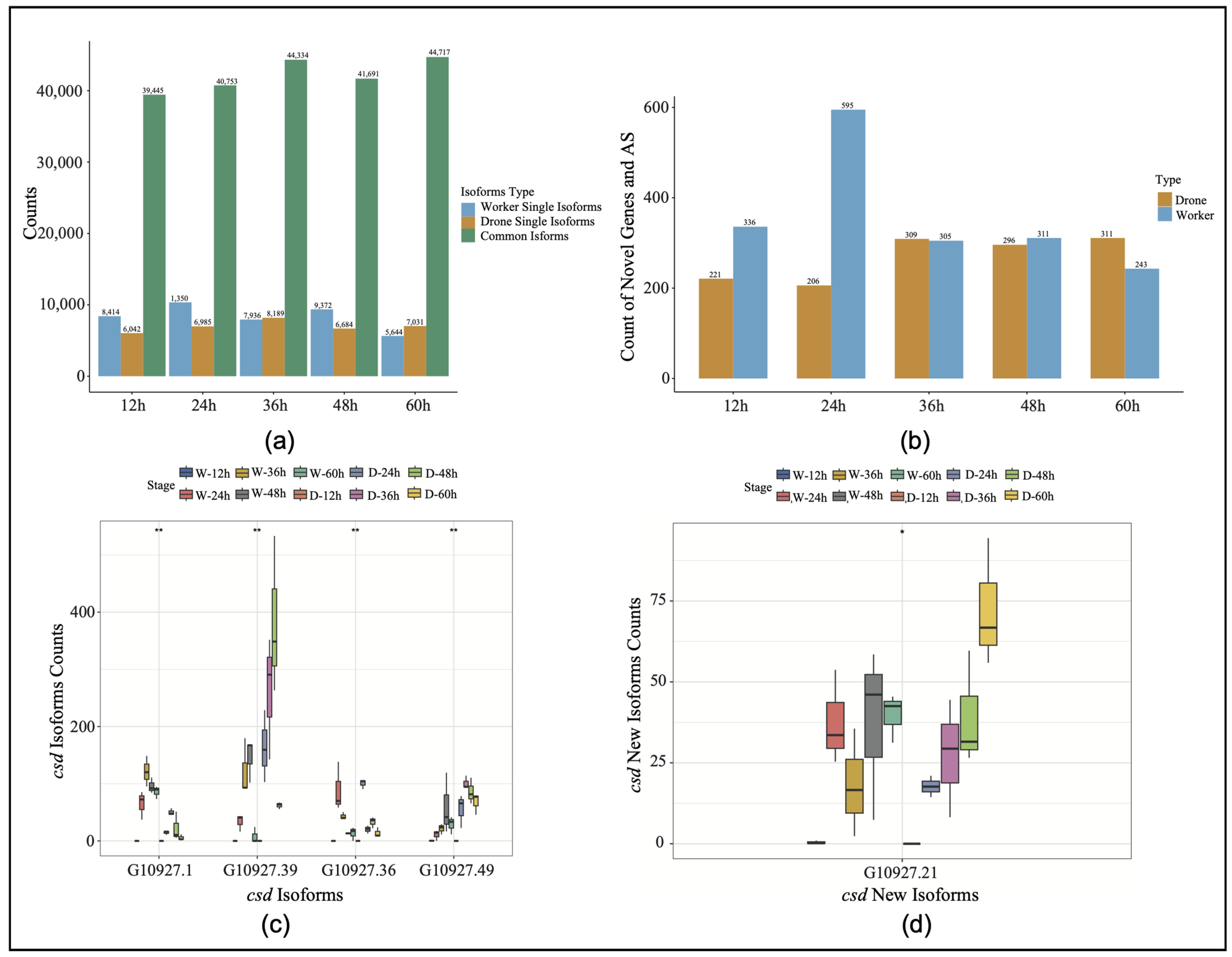
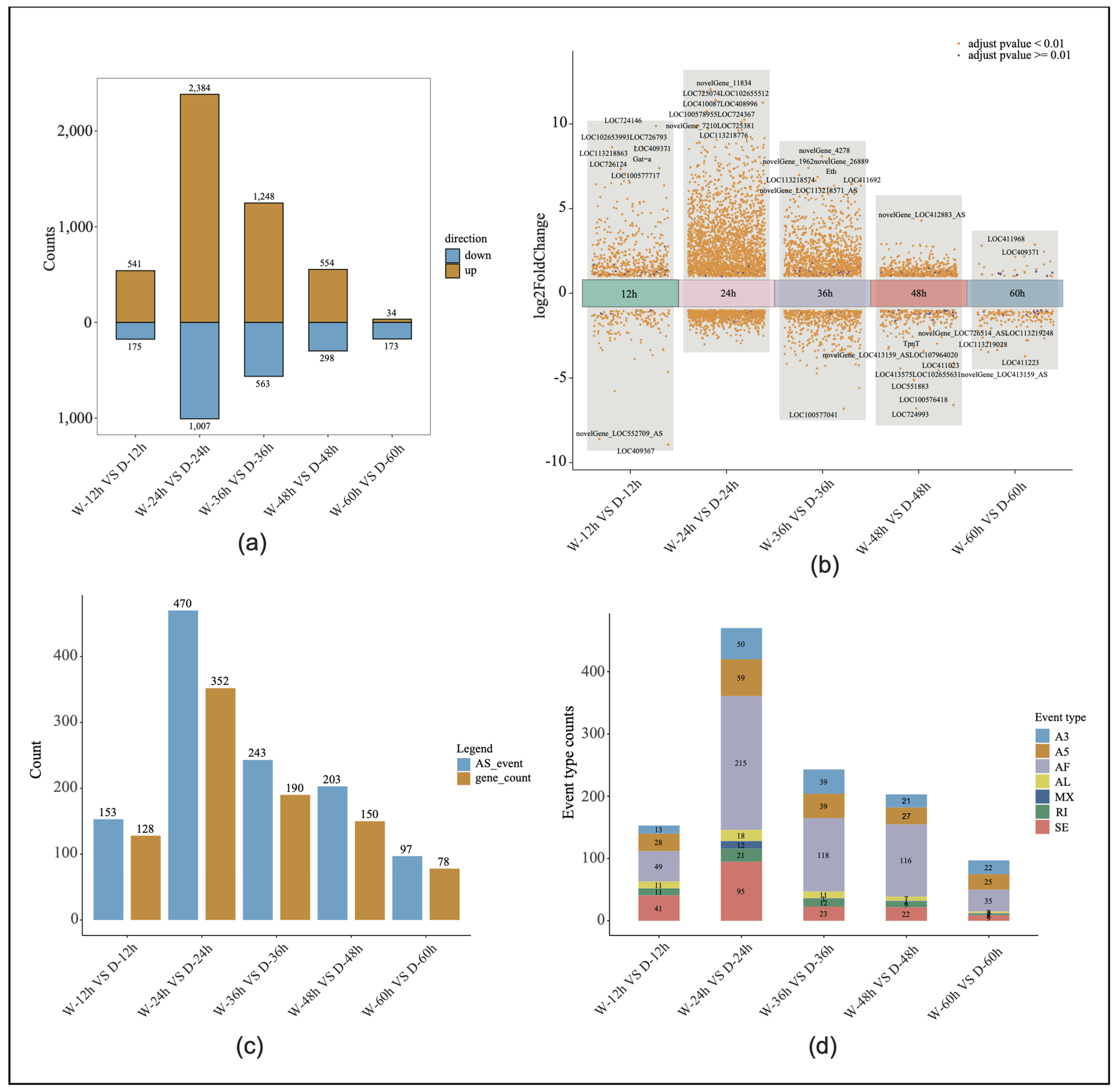
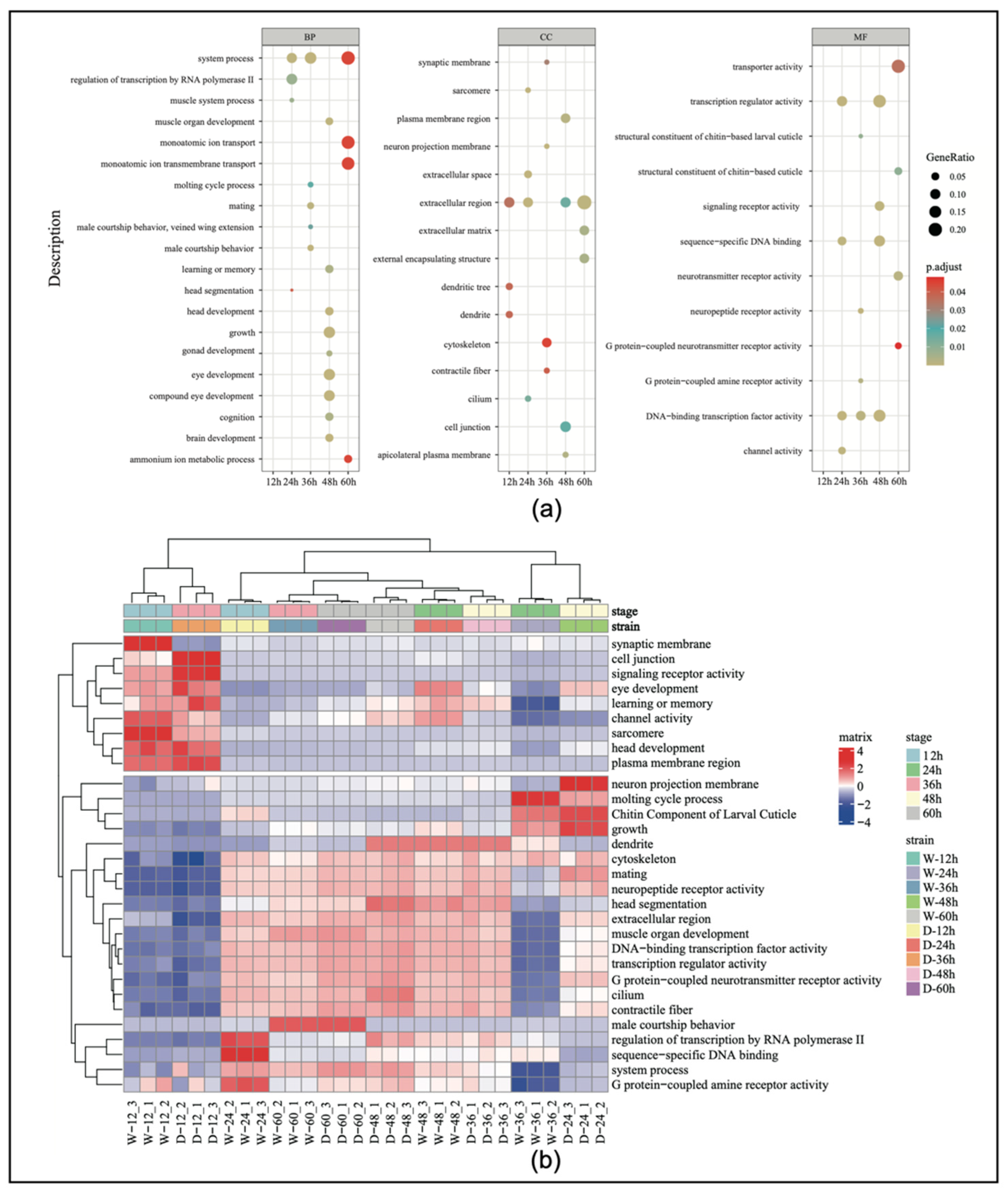
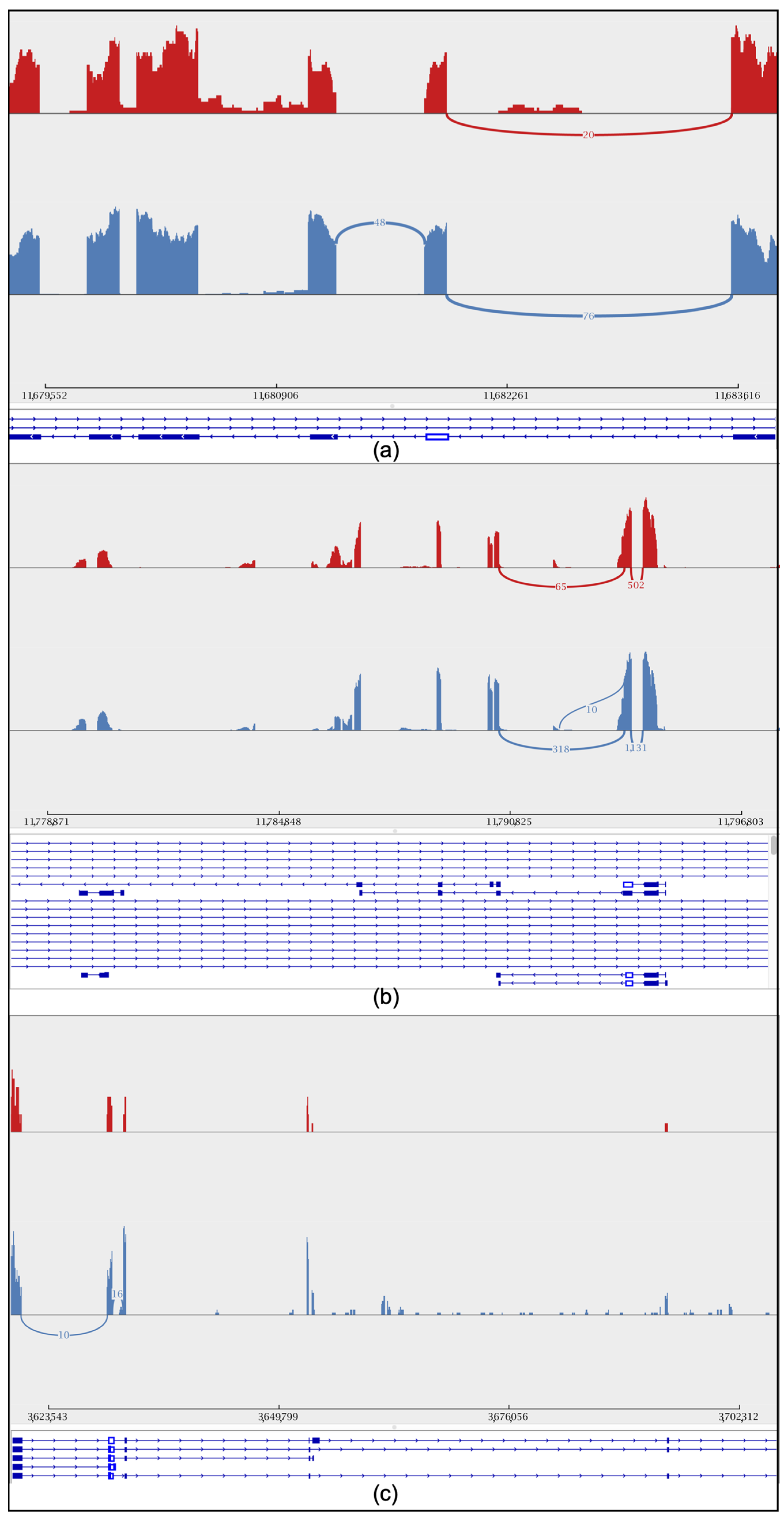
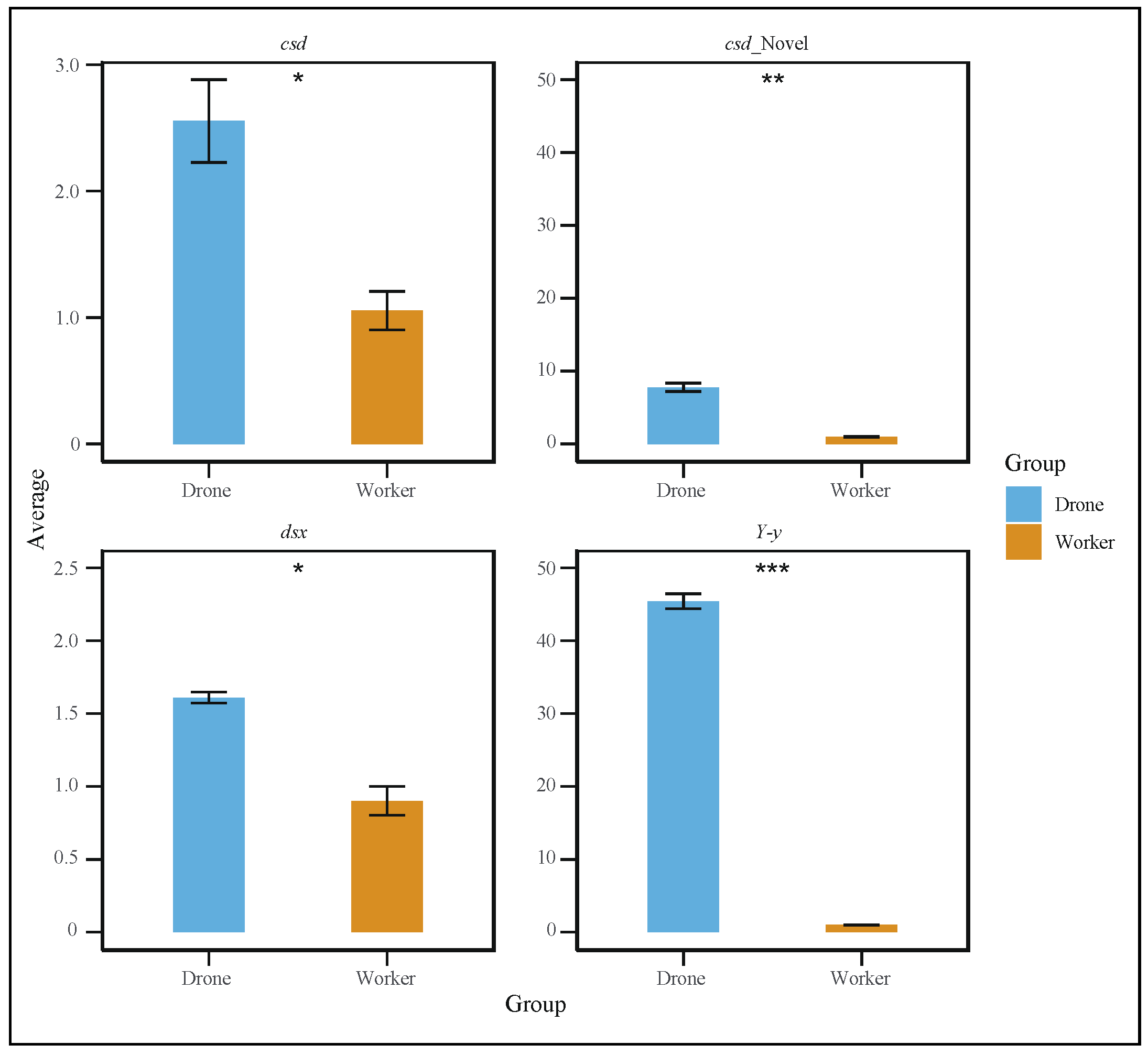
Disclaimer/Publisher’s Note: The statements, opinions and data contained in all publications are solely those of the individual author(s) and contributor(s) and not of MDPI and/or the editor(s). MDPI and/or the editor(s) disclaim responsibility for any injury to people or property resulting from any ideas, methods, instructions or products referred to in the content. |
© 2025 by the authors. Licensee MDPI, Basel, Switzerland. This article is an open access article distributed under the terms and conditions of the Creative Commons Attribution (CC BY) license (https://creativecommons.org/licenses/by/4.0/).
Share and Cite
Su, R.; Chen, Y.; Zhu, R.; Ding, G.; Dong, K.; Feng, M.; Huang, J. Transcriptomic Analysis Reveals Patterns of Expression of Stage-Specific Genes in Early Apis cerana Embryos. Genes 2025, 16, 187. https://doi.org/10.3390/genes16020187
Su R, Chen Y, Zhu R, Ding G, Dong K, Feng M, Huang J. Transcriptomic Analysis Reveals Patterns of Expression of Stage-Specific Genes in Early Apis cerana Embryos. Genes. 2025; 16(2):187. https://doi.org/10.3390/genes16020187
Chicago/Turabian StyleSu, Runlang, Yuhui Chen, Rui Zhu, Guiling Ding, Kun Dong, Mao Feng, and Jiaxing Huang. 2025. "Transcriptomic Analysis Reveals Patterns of Expression of Stage-Specific Genes in Early Apis cerana Embryos" Genes 16, no. 2: 187. https://doi.org/10.3390/genes16020187
APA StyleSu, R., Chen, Y., Zhu, R., Ding, G., Dong, K., Feng, M., & Huang, J. (2025). Transcriptomic Analysis Reveals Patterns of Expression of Stage-Specific Genes in Early Apis cerana Embryos. Genes, 16(2), 187. https://doi.org/10.3390/genes16020187






